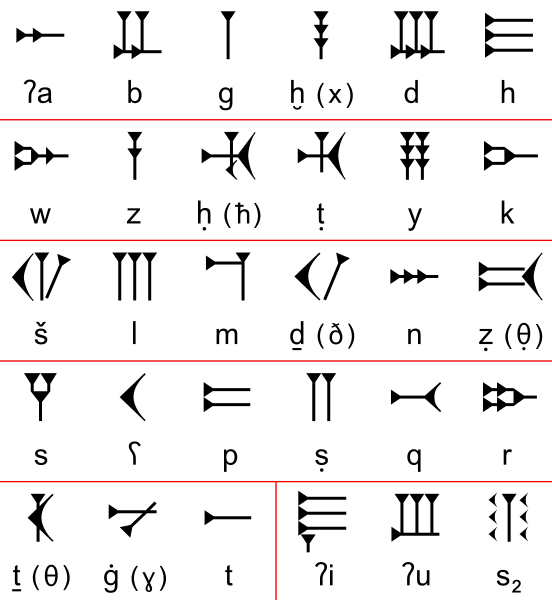Datei:Ugaritic-alphabet-chart.svg

Größe der PNG-Vorschau dieser SVG-Datei: 552 × 600 Pixel. Weitere Auflésungan: 221 × 240 Pixel | 442 × 480 Pixel | 707 × 768 Pixel | 942 × 1.024 Pixel | 1.884 × 2.048 Pixel | 622 × 676 Pixel.
Version in hechara Auflesung (SVG-Datei, Basisgress: 622 × 676 Pixl, Dateigress: 28 KB)
Dateiversiona
Wensd auf an Zeitpunkt klickst, nacha konst a friaane Version lodn.
| Version vom | Vorschaubuidl | Dimensióna | Nutzer | Kommentar | |
|---|---|---|---|---|---|
| aktuell | 16:23, 13. Mer. 2012 |  | 622 × 676 (28 KB) | AnonMoos | tweaking crossbar of ħ |
| 03:13, 9. Mer. 2012 |  | 622 × 676 (28 KB) | AnonMoos | Table of letters of the Ugaritic cuneiform alphabet, with a conventional transcription. Where the "Semitological" symbols are somewhat divergent from the IPA symbol for the letter's probable pronunciation, the I... |
Dateivawendung
Seitn wo de Datei nutzn:
Globale Dateinutzung
D'noochéfóiganden åndern Wikis vawénden dé Datei:
- Vawendung af af.wikipedia.org
- Vawendung af am.wikipedia.org
- Vawendung af ar.wikipedia.org
- Vawendung af ast.wikipedia.org
- Vawendung af be.wikipedia.org
- Vawendung af bg.wikipedia.org
- Vawendung af ca.wikipedia.org
- Vawendung af de.wikipedia.org
- Vawendung af el.wikipedia.org
- Vawendung af en.wikipedia.org
- Vawendung af en.wiktionary.org
- Vawendung af eo.wikipedia.org
- Vawendung af es.wikipedia.org
- Vawendung af fa.wikipedia.org
- Vawendung af fr.wikipedia.org
- Vawendung af gl.wikipedia.org
- Vawendung af got.wikipedia.org
- Vawendung af he.wikipedia.org
- Vawendung af id.wikipedia.org
- Vawendung af it.wikipedia.org
- Vawendung af ja.wikipedia.org
- Vawendung af kk.wikipedia.org
- Vawendung af ko.wikipedia.org
- Vawendung af lfn.wikipedia.org
- Vawendung af ml.wikipedia.org
- Vawendung af nl.wikipedia.org
- Vawendung af no.wikipedia.org
- Vawendung af pl.wikipedia.org
- Vawendung af ru.wikipedia.org
- Vawendung af rw.wikipedia.org
- Vawendung af sl.wikipedia.org
- Vawendung af sr.wikipedia.org
- Vawendung af sv.wikipedia.org
- Vawendung af th.wikipedia.org
- Vawendung af uk.wikipedia.org
- Vawendung af uz.wikipedia.org
- Vawendung af zh.wikipedia.org
